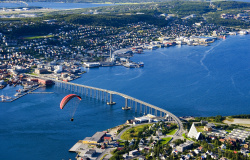Difference between revisions of "Archive:Tigáacaqits"
Jump to navigation
Jump to search
m (dang this needs expansion but for now just uh name updates) |
m |
||
| Line 100: | Line 100: | ||
}} | }} | ||
'''Tigáacaqits''' ([[Tsaavalu]] /tɪ'gatʃ͡akɪts/), also rendered '''Tigáatgiaqits''' ([[Achiyitqan]] /tɪgɑ̂:tdʒaqɪts/) is the largest city in [[Achiyitqana]] and its most common capital city. Located | '''Tigáacaqits''' ([[Tsaavalu]] /tɪ'gatʃ͡akɪts/), also rendered '''Tigáatgiaqits''' ([[Achiyitqan]] /tɪgɑ̂:tdʒaqɪts/) is the largest city in [[Achiyitqana]] and its most common capital city. Located north of the [[Bay of Kasiiralq]], the city is located on the southern side of an isthmus which connects the [[Nəqumlug peninsula]] to the rest of Miraria. It has been inhabited by hominids for tens of thousands of years. | ||
==Etymology== | ==Etymology== | ||
Revision as of 23:10, 26 July 2022
Tigáacaqits | |
|---|---|
 Tigáatgiaqits in July | |
| Etymology: Whale-catching bay | |
| Nickname(s): Tigaaq | |
| Country | Achiyitqana |
| State | Tsaabkulbaa |
| Population (2014) | |
| • Total | 420,630 |
Tigáacaqits (Tsaavalu /tɪ'gatʃ͡akɪts/), also rendered Tigáatgiaqits (Achiyitqan /tɪgɑ̂:tdʒaqɪts/) is the largest city in Achiyitqana and its most common capital city. Located north of the Bay of Kasiiralq, the city is located on the southern side of an isthmus which connects the Nəqumlug peninsula to the rest of Miraria. It has been inhabited by hominids for tens of thousands of years.
Etymology
Tigáacaqits is a descriptive name in modern Achiyitqan, meaning 'Whale-catching Bay,' also one of the Achiyitqan names for the bay on which it is situated.